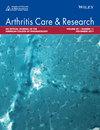Factors for Consideration by Pediatric Rheumatologists When Scoring the Physician Global Assessment of Disease Activity in Juvenile Idiopathic Arthritis: First Step Toward an Internal Consensus
Abstract
Objective
The physician global assessment of disease activity (PhGA) is a tool used nearly ubiquitously by pediatric rheumatologists for the assessment of patient disease activity status. However, this tool lacks standardization in its scoring. This survey aimed to identify score influencing factors, along with inclusion or exclusion of extra-articular manifestations and imaging, when scoring the PhGA in juvenile idiopathic arthritis (JIA).
Methods
Electronic surveys were sent to Paediatric Rheumatology International Trials Organisation and Pediatric Rheumatology Care and Outcomes Improvement Network members who completed a previous survey on scoring of the PhGA. Respondents were asked to rank their top seven factors for inclusion in the PhGA for nonsystemic JIA (nsJIA) and systemic JIA (sJIA), along with ranking extra-articular manifestations and imaging for inclusion. Frequency and percentage of rank and Likert responses were analyzed, and geographic regions as well as level of experience were compared using the chi-square test and Fisher's test.
Results
A total of 276 respondents from 54 countries and six continents participated. For nsJIA, factors selected by >50% included number of swollen joints, active uveitis, duration of morning stiffness, and number of tender joints. For sJIA, factors selected by >50% were presence and duration of fever, laboratory tests, number of swollen joints, serositis, rash, hepatomegaly, lung disease, and lymphadenopathy. Agreement on the inclusion of extra-articular factors, such as uveitis, macrophage activation syndrome, and sJIA-associated lung disease, had >70% moderate or strong agreement for inclusion, whereas psoriasis had only 50.5% agreement for inclusion and imaging had 64.7% agreement for inclusion. Variations in rank between different geographic regions or level of experience were minor.
Conclusion
This survey identifies factors that pediatric rheumatology providers find important for PhGA scoring of disease activity, documents varying agreement on inclusion of extra-articular manifestations of disease, and lays the framework for further consensus work.

 求助内容:
求助内容: 应助结果提醒方式:
应助结果提醒方式:


